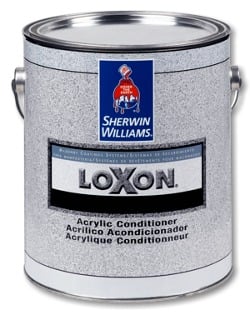A question that we often get when customers are planning to re-paint the stucco on the exterior of their homes is about the necessity of using Sherwin-Williams' Loxon Conditioner, or other masonry conditioners, before applying their paint topcoat. While Loxon Conditioner is a wonderful product when used in the appropriate situation, its widespread use on homes -- especially those in coastal areas -- may very well exceed its intended purpose.
If you're collecting bids for your stucco painting project, don't be surprised if many of them will include a specification for 1 coat of Loxon Conditioner followed by 1 coat of an acrylic topcoat. While this has become the accepted norm in these regions of the country, the reason your painting contractor is suggesting this system is likely not in your best interest.

What Is Loxon Conditioner?
Loxon is a line of specialty masonry coatings made by the Sherwin-Williams company that includes primers, block surfacers, conditioners, stains, and topcoats. This conditioner was designed to help "tie-down" or bond lightly-chalking concrete and masonry so the paint topcoat will adhere better to the surface. In addition, it allows the applicator to paint over masonry surfaces that have been curing for as little as 7 days, as opposed to normal primers/paints that require a 30-day cure time prior to application.
While all of this sounds great there are many things that this product just cannot do.
It Cannot Make Up For A Lack Of Surface Prep
The biggest danger in using masonry conditioners is that we see too many painting contractors that -- sometimes intentionally, sometimes unwittingly -- misinterpret their chalk-bonding ability to mean that they don't need to spend as much time removing the chalk and other surface contaminants from your home. Let me say, in no uncertain terms, that there is no productavailable on the market today that will allow a contractor to successfully paint over an improperly-prepared surface without the homeowner suffering the consequences.
While the coatings industry has developed some amazing labor-saving products in recent years that will enable painting contractors to apply less coats without sacrificing quality or longevity of the paint job, Loxon Conditioner is not one of them...regardless of what your painter tells you. If they try to convince you otherwise they are either misinformed or trying to skimp on labor hours to give you a lower bid – while “a lower bid” may sound good, we assure you this is not doing you a favor.
Proper exterior surface prep should always include a thorough surface cleaning with a high quality pre-paint cleaner to allow the primer and/or topcoat to stick to the substrate and not to the debris on the surface.
It Cannot Achieve The Film-Build Needed To Give Optimal Protection For Your Home
The purpose of a dried paint film is to act as a barrier between your home's substrate and nature's elements (rain, UV rays, salt-water air, etc). The ideal recommended film thickness to give you this protection with most latex finish paints is 2 topcoats at 1.5 mils Dry Film Thickness per coat, or a total of 3 mils dry.
The issue with relying on Loxon Conditioner to help you achieve your dry thickness is that it is a thin, penetrating product that builds very little film on the surface -- not effectively helping you to to obtain your optimal build.
Is There A Better Choice?
If you want the coating on your home to last longer, there are better options.
- 2-Coat System - Once you've done the proper surface prep simply apply 2 full coats of a high quality 100% acrylic paint such as Sherwin-Williams' SuperPaint
- 1-Coat System - There are legitimate 1-coat systems available for those who are looking to save on labor costs. Products such as Sherwin-Williams' Duration or Emerald were designed to be able to be applied at twice the wet film thickness as normal paints without sagging or running down the wall. After the surface prep is complete, you can apply 1 heavy coat at 7-8 mils wet and still get your desired total dry film thickness. Although this will obviously save on labor costs you should be prepared to pay substantially more for your paint materials, as the cost per gallon of these types of products is certainly higher. Be aware that this is only acceptable practice if the painting contractor you are using applies the paint correctly and achieves the proper mil build. An unscrupulous contractor wanting to make good profit on a low-priced job or a painter who simply isn’t properly trained in the application of these products may end up applying them at the same spread rate as standard paints, in which case your job may look fine but it won’t last as long as properly applied paint or a quality two coat system.
The takeaway from this article should be that a masonry conditioner is not often necessary when re-painting stucco, unless after performing a full preparation of the surface there is still a light layer of chalk present. Even then, a thin masonry conditioner should never be used in-place of a film-building paint coating as protection for your home if what you desire is maximum longevity.
If you're located in the Greater Tampa area and you need help with your stucco painting project, please give us a call at (813) 570-8800 or click on the button below.
Photo by: Sherwin-Williams